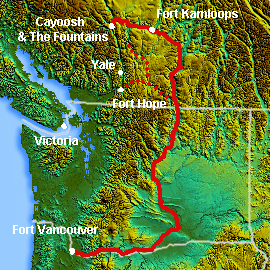Okanagan Trail facts for kids
The Okanagan Trail was an important path used by people traveling to the Fraser Canyon Gold Rush in 1858 and 1859. This trail was an inland route, meaning it went through the land instead of along the coast. It started from the Columbia River area in what were then the Washington Territory and Oregon Territory.
The trail largely followed the same path that Hudson's Bay Company fur traders had used for years. It went along the Columbia River until it met the Okanogan River. From there, it followed the Okanogan River's path, passing by Osoyoos Lake, Skaha Lake (which used to be called Dog Lake), and Okanagan Lake.
After the lakes, the trail went through a pass near Monte Creek to Fort Kamloops. This fort was located where the North Thompson River and South Thompson River meet.
From Fort Kamloops, travelers headed west along the Thompson River. They could then go to the lower parts of the Fraser River where gold was found, between what are now the towns of Lytton, British Columbia and Yale, British Columbia. Or, they could take another path through Hat Creek and Marble Canyon to the upper Fraser goldfields. These upper goldfields were around the area known today as Lillooet, British Columbia.
There was also a shorter path that split off from the main trail near where the Similkameen River meets the Okanogan River (close to modern-day Oroville, Washington). This shorter path led directly to the lower Thompson River and the lower Fraser Canyon.
Contents
Why the Okanagan Trail Was Important
The Okanagan Trail played a big role during the Fraser Canyon Gold Rush. It offered a way for many people from the United States to reach the goldfields in what is now British Columbia, Canada.
The Gold Rush Connection
The Fraser Canyon Gold Rush attracted thousands of people hoping to find gold. Many of these prospectors came from the United States. The Okanagan Trail provided a direct land route for them to travel north.
A Path for Trade and Travel
Before the gold rush, the trail was mainly used by fur traders. They transported furs and supplies between trading posts. When gold was discovered, the trail became busy with miners, merchants, and others. They brought goods and services to the growing gold rush towns.
The Route Details
The Okanagan Trail followed natural waterways and passes. This made it a somewhat easier route than trying to cross rugged mountains directly.
Starting Point
The trail began in the Lower Columbia River region. This area was part of the Washington Territory and Oregon Territory at the time. Travelers would start their journey there and head north.
Following the Rivers and Lakes
The main part of the trail followed the Columbia River north. Then, it turned onto the Okanogan River. This river led to a chain of lakes: Osoyoos Lake, Skaha Lake, and Okanagan Lake. Traveling along these lakes often involved canoes or small boats.
Reaching the Goldfields
After the lakes, the trail continued overland to Fort Kamloops. From there, travelers had options to reach different gold-mining areas along the Fraser River. Some went to the lower Fraser Canyon, while others aimed for the upper goldfields near Lillooet, British Columbia.
Life on the Trail
Traveling the Okanagan Trail was not easy. It required strength, determination, and supplies.
Challenges for Travelers
People on the trail faced many difficulties. They had to deal with tough terrain, changing weather, and limited supplies. The journey could be long and tiring.
Interaction with Indigenous Peoples
The trail passed through the traditional lands of several Indigenous groups, including the Syilx (Okanagan) people. These groups had used these paths for centuries. Sometimes, Indigenous people helped travelers by guiding them or trading supplies.
Legacy of the Trail
Even after the gold rush ended, parts of the Okanagan Trail continued to be used. It helped shape the development of the region.
Early Settlements
The trail contributed to the growth of early settlements and towns along its path. Places like Kamloops and Lillooet became important centers.
Historical Significance
Today, the Okanagan Trail is remembered as an important part of the history of British Columbia and the Pacific Northwest. It shows how people traveled and traded during the gold rush era.
Images for kids
See also
 In Spanish: Ruta Okanagan para niños
In Spanish: Ruta Okanagan para niños



